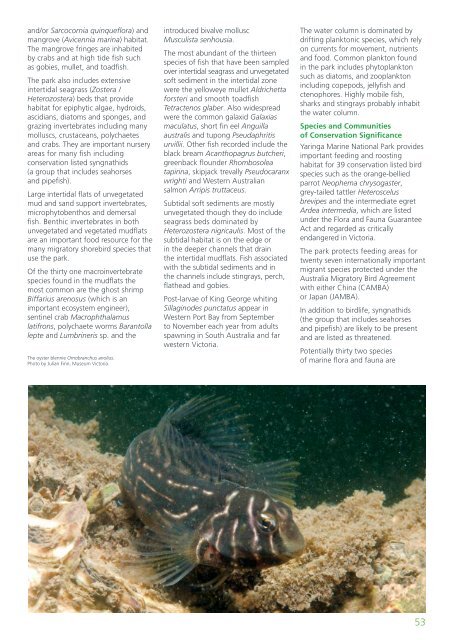Marine Natural Values Study Summary - Parks Victoria
Marine Natural Values Study Summary - Parks Victoria
Marine Natural Values Study Summary - Parks Victoria
You also want an ePaper? Increase the reach of your titles
YUMPU automatically turns print PDFs into web optimized ePapers that Google loves.
and/or Sarcocornia quinqueflora) andmangrove (Avicennia marina) habitat.The mangrove fringes are inhabitedby crabs and at high tide fish suchas gobies, mullet, and toadfish.The park also includes extensiveintertidal seagrass (Zostera /Heterozostera) beds that providehabitat for epiphytic algae, hydroids,ascidians, diatoms and sponges, andgrazing invertebrates including manymolluscs, crustaceans, polychaetesand crabs. They are important nurseryareas for many fish includingconservation listed syngnathids(a group that includes seahorsesand pipefish).Large intertidal flats of unvegetatedmud and sand support invertebrates,microphytobenthos and demersalfish. Benthic invertebrates in bothunvegetated and vegetated mudflatsare an important food resource for themany migratory shorebird species thatuse the park.Of the thirty one macroinvertebratespecies found in the mudflats themost common are the ghost shrimpBiffarius arenosus (which is animportant ecosystem engineer),sentinel crab Macrophthalamuslatifrons, polychaete worms Barantollalepte and Lumbrineris sp. and theThe oyster blennie Omobranchus anolius.Photo by Julian Finn, Museum <strong>Victoria</strong>.introduced bivalve molluscMusculista senhousia.The most abundant of the thirteenspecies of fish that have been sampledover intertidal seagrass and unvegetatedsoft sediment in the intertidal zonewere the yelloweye mullet Aldrichettaforsteri and smooth toadfishTetractenos glaber. Also widespreadwere the common galaxid Galaxiasmaculatus, short fin eel Anguillaaustralis and tupong Pseudaphritisurvillii. Other fish recorded include theblack bream Acanthopagrus butcheri,greenback flounder Rhombosoleatapirina, skipjack trevally Pseudocaranxwrighti and Western Australiansalmon Arripis truttaceus.Subtidal soft sediments are mostlyunvegetated though they do includeseagrass beds dominated byHeterozostera nigricaulis. Most of thesubtidal habitat is on the edge orin the deeper channels that drainthe intertidal mudflats. Fish associatedwith the subtidal sediments and inthe channels include stingrays, perch,flathead and gobies.Post-larvae of King George whitingSillaginodes punctatus appear inWestern Port Bay from Septemberto November each year from adultsspawning in South Australia and farwestern <strong>Victoria</strong>.The water column is dominated bydrifting planktonic species, which relyon currents for movement, nutrientsand food. Common plankton foundin the park includes phytoplanktonsuch as diatoms, and zooplanktonincluding copepods, jellyfish andctenophores. Highly mobile fish,sharks and stingrays probably inhabitthe water column.Species and Communitiesof Conservation SignificanceYaringa <strong>Marine</strong> National Park providesimportant feeding and roostinghabitat for 39 conservation listed birdspecies such as the orange-belliedparrot Neophema chrysogaster,grey-tailed tattler Heteroscelusbrevipes and the intermediate egretArdea intermedia, which are listedunder the Flora and Fauna GuaranteeAct and regarded as criticallyendangered in <strong>Victoria</strong>.The park protects feeding areas fortwenty seven internationally importantmigrant species protected under theAustralia Migratory Bird Agreementwith either China (CAMBA)or Japan (JAMBA).In addition to birdlife, syngnathids(the group that includes seahorsesand pipefish) are likely to be presentand are listed as threatened.Potentially thirty two speciesof marine flora and fauna are53
















